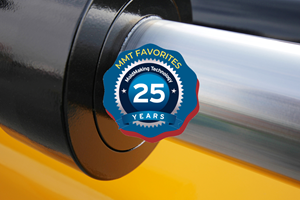Throwback Thursday: Criteria for Effective EDM
The work metal, EDM process priority, electrode material and machine are the four main considerations for effective EDM of non-standard alloys. These four areas play a critical role in making the overall EDM process profitable. Read this archived article for more.
in terms of the work metal (material being machined), elemental structure, melting point/temperature and thermal conductivity will impact how it is machined on the EDM. Since EDM is a thermal process, the melting point/temperature and thermal conductivity of the work metal can create difficulties for the EDM operator (see chart below). Knowing the elements that make up the material will help determine the optimum melting point/temperature and thermal conductivity.
Work metals such as copper and copper alloys have low melting points and high thermal conductivity, which dictate how the work metal will react to the heat of the spark. For example, a highly conductive work metal will dissipate the spark energy quickly throughout the material. Other metals, such as tungsten and carbide, have higher melting points and lower thermal conductivity, and require a spark hot enough to bring them to their melting points but not so hot as to destroy the integrity of the material.
The work metal’s melting temperature and thermal conductivity require the EDM operator to adjust on-time, amperage, polarity, voltage and off-time parameters, which differ from one
work metal to another. If the same EDM approach is used regardless of work metal, the end results could be vastly different.
The EDM process priority refers to the desired metal removal rate, electrode wear and surface finish. This information helps the operator determine the best approach to the job. However, regardless of what is identified as the main priority, electrode size, detail and shape must be known in order to determine the appropriate machine parameters, including amperage, on time, off time, voltage and polarity.
When deciding on electrode material, it is important to look at its structure. Graphite can vary in particle size, uniformity, material hardness, flexural and compressive strengths, apparent density, and electrical resistivity. Metallic electrodes can vary in material hardness, flexural and compressive strengths, and electrical resistivity. Some questions to ask before selecting the electrode material include:
• Which material holds up during both machining and the EDM process without chipping, flexing, warping or expanding as a result of the heat generated from both processes?
• How will the electrode material affect the cutters being used to machine it (how fast will these cutters wear out)?
• How long will it take to machine each electrode, and will the electrode need secondary operations (such as deburring or polishing)?
• During the EDM process, how will the electrode material hold up to the work metal?
• Can the electrode material achieve the speed necessary to
get the maximum metal removal rate (MRR) with minimal electrode wear and the required surface finish?
Determining the number of required electrodes is based on the part detail requirements, depth of the machining, surface finish, tolerance and the number of parts required.
There are several brands of EDMs that offer a wide variety of features and options, including ease of programming, toolchangers or robots for automation, high-speed axes, generators with a variety of power supplies, databases for cutting conditions appropriate for electrode materials and work metals, and adaptive controls to monitor cutting conditions.
Related Content
How to Correctly Size a Hydraulic Cylinder
This week Randy shares steps for correctly sizing a hydraulic cylinder on a mold.
Read MoreRevisiting Some Hot Runner Fundamentals
What exactly does a hot runner do? If you’ve been in the injection molding industry for any length of time, you might think the answer is obvious, but it is not.
Read MoreMaking Quick and Easy Kaizen Work for Your Shop
Within each person is unlimited creative potential to improve shop operations.
Read MoreRead Next
Reasons to Use Fiber Lasers for Mold Cleaning
Fiber lasers offer a simplicity, speed, control and portability, minimizing mold cleaning risks.
Read MoreHow to Use Strategic Planning Tools, Data to Manage the Human Side of Business
Q&A with Marion Wells, MMT EAB member and founder of Human Asset Management.
Read MoreAre You a Moldmaker Considering 3D Printing? Consider the 3D Printing Workshop at NPE2024
Presentations will cover 3D printing for mold tooling, material innovation, product development, bridge production and full-scale, high-volume additive manufacturing.
Read More






















